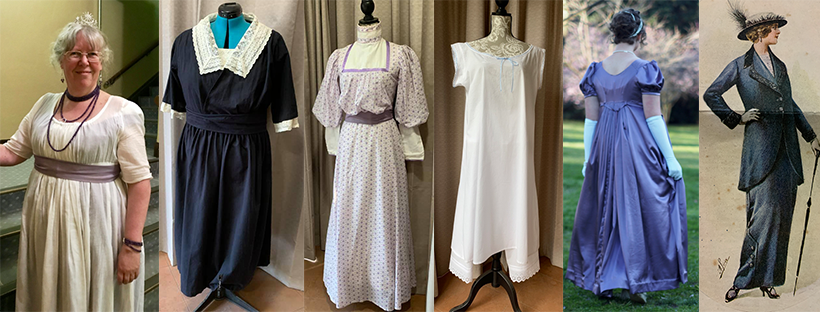I finished this skirt a couple of months ago but it had its first outing yesterday. It is loosely inspired by the skirt of a matching bodice and skirt that I have documented and displayed at the Armidale Folk Museum.
The original outfit is made of a pale green linen, with cream cotton lace. The lighting in this first image of the outfit unfortunately doesn’t show the colour well. However, of importance to this project are the pleats on the skirt, just discernible:

Here’s a detail look at one of them:

The original skirt has 6 gores, a narrow waistband, a pleat on either side of the centre-back, and a side-front button closing. The back gores are wider at the hem than the front gores, giving the characteristic back fullness that is typical of the late 1890s/early 1900s.
I made my skirt out of a cotton sateen sheet, in a light purple colour. For the pattern, I used as a base a 6-gore skirt from a dress pattern in La Mode Illustrée, issue 5, 1900.

The pattern, of course, was for a much smaller size than me. I have made several skirts using these pattern pieces, enlarged to fit me while keeping the waist to hem proportions vaguely similar.
For this skirt, with the pleat details on the front and back seams, I added extra to form the pleats (each pleat is about 3 inches wide, which meant adding 6 inches to form each pleat. I used a white cotton lace from my stash for the lace decoration.

I am making a matching blouse, using the Black Snail Edwardian Blouse pattern, but I made a stupid mistake with the sleeves and so haven’t finished it yet.
I wore the skirt yesterday at another museum I volunteer at, which is in an 1896 school building. We don’t usually dress historically but there was a family picnic day in the village so I decided to give the skirt its first outing. The shape of the belt is HA but the lace applique probably isn’t – I’ve not seen anything quite like it but it needed something and I had the lace handy. The blouse is a wearable mockup of the Wearing History 1910s blouse, but with the high neck I think it’s appropriate for the early 1900s. I confess I’m wearing an 1882 corset rather than a 1902 corset so the shape isn’t quite right, but the basic cotton petticoat, cut based on the skirt pattern, does hold the skirt out nicely.
Unfortunately it rained heavily as I arrived and my skirt is a tad long, hence the damp hem, but overall I was happy with the skirt’s first appearance.
